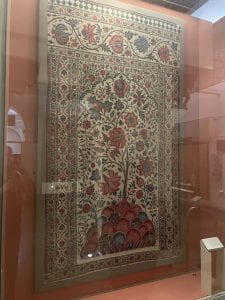Tucked away in the rolling hills and fertile fields of the Cotswolds is Kelmscott Manor, former home of William Morris, his wife Jane, and their two daughters, May and Jane Alice. Morris was a British textile designer and member of both the Arts and Crafts Movement and the Pre-Raphaelite Brotherhood. Both focused on a return to traditional artistic styles and methods of production. As Morris relates to Indian Civilization, his work with textiles is most pertinent. While the patterns and textiles he produced are often taken to be of a traditionally British style, his inspiration was derived from designs originating in India.
Kelmscott Manor is beautifully adorned in textiles extremely reminiscent of those found in India. In the early 18th century, block printed cotton textiles began to be imported to Great Britain from India by the upper classes. Block printing is a labor-intensive process requiring great precision. First, detailed designs are carved into wooden blocks of robust varieties such as teak. Next, the block is dipped into dyes or pigments and pressed onto the fabric square by square in order to create the full pattern. Finally, this process is repeated until the fabric is uniformly and vibrantly dyed. Considered a luxury at this stage, they were not yet accessible for the British masses. By the end of the 18th century, however, the styles seen in Indian textiles began to be mass produced in Europe, transitioning them into a far more accessible space and allowing them to become a fabric for everyday wear by the masses.
Moving into the 19th century, William Morris and the Arts and Craft Movement at large press for a return to traditional, artisanal techniques such as block printing. As a result, Kelmscott Manor is fully fitted in textiles of this original Indian style. From curtains and wall hangings to bedspreads and wall papers, the home is saturated in Indian influence. The designs, such as the famous Strawberry Thief, are original to William Morris, but they are made possible by the tradition of Indian textiles.
This connection between Britain and India is further illuminated by the William Morris pieces incorporated into the Indian Civilization exhibit at the Victoria and Albert Museum. Their thoughtful placement in this section of the museum speaks volumes. Placed not at the center of this exhibit, but instead along the perimeter, the relationship between Morris, India, and the textile industry at large is illustrated. While not critical to Indian history in the way that artifacts such as the Mughal miniatures are, these British textiles derive their inspiration from traditional Indian styles and must be displayed in a way that pays proper homage. The Victoria and Albert Museum tactfully executes this in a way that I can only hope visitors new to the topic recognize.



